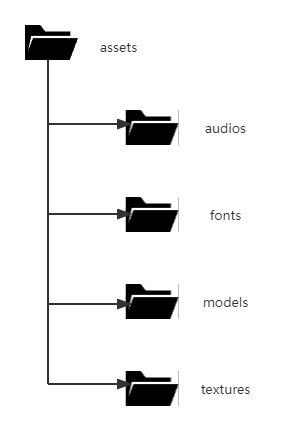# 资源
# 资源路径
通过AssetsPath的静态属性设置或获取资源路径。
🌏 rootPath 默认资源根路径
import { AssetsPath } from '@tx3d/core';
// 获取默认资源根路径
const rootPath = AssetsPath.rootPath;
// 设置默认资源根路径
AssetsPath.rootPath = '../assets/';
2
3
4
5
6
7
🌏 audiosPath 默认音频资源根路径(只读)
import { AssetsPath } from '@tx3d/core';
// 获取告警音频资源路径
const path = `${AssetsPath.audiosPath}alarm.wav`;
2
3
4
5
🌏 fontPaths 默认字体资源根路径(只读)
import { AssetsPath } from '@tx3d/core';
// 获取"DS-DIGIB"字体资源路径
const path = `${AssetsPath.fontPaths}DS-DIGIB.TTF`;
2
3
4
🌏 modelsPath 默认模型资源根路径(只读)
import { AssetsPath } from '@tx3d/core';
// 获取液压支架模型资源路径
const path = `${AssetsPath.modelsPath}液压支架/液压支架.gltf`;
2
3
4
🌏 texturesPath 默认纹理资源根路径(只读)
import { AssetsPath } from '@tx3d/core';
// 获取“Grid”纹理资源路径
const path = `${AssetsPath.texturesPath}Grid.png`;
2
3
4
提示
内置资源默认目录结构如下图所示:

# 模型资源
模型资源(ModelAsset)用于记录加载完成的模型数据。
# 模型资源属性
🌏 url 模型资源路径,只读。
🌏 type 模型资源类型(OBJ、FBX、GLTF),只读。
🌏 data 模型数据,只读。
🌏 refCount 模型资源引用计数,只读。
# 模型资源接口
🌏 reference 引用模型资源
// 引用模型资源
const asset = modelAsset.reference();
2
注意
调用“reference”接口会递增引用计数并复用当前模型资源。
🌏 dispose 释放模型资源
// 释放模型资源
modelAsset.dispose();
2
注意
调用“dispose”接口会递减引用计数,只有当引用计数等于0时才会释放模型数据。
# 纹理资源
纹理资源(TextureAsset)用于记录加载完成的纹理数据。
# 纹理资源属性
🌏 url 纹理资源路径,只读。
🌏 texture 纹理数据,只读。
🌏 refCount 纹理资源引用计数,只读。
# 纹理资源接口
🌏 reference 引用纹理资源
// 引用纹理资源
const asset = textureAsset.reference();
2
注意
调用“reference”接口会递增引用计数并复用当前纹理资源。
🌏 dispose 释放纹理资源
// 释放纹理资源
textureAsset.dispose();
2
注意
调用“dispose”接口会递减引用计数,只有当引用计数等于0时才会释放纹理数据。
提示
推荐使用 AssetsManager 的 disposeTexture 接口释放 three.js 的原生纹理对象(Texture),其内部会自动判断纹理对象是否属于某纹理资源(TextureAsset),然后选择合适的释放逻辑。
# 加载资源
使用AssetsManager的静态接口加载文件、模型、纹理等资源。
# 加载文件资源
使用AssetsManager的loadFile接口加载文件资源。
import { AssetsPath, AssetsManager } from '@tx3d/core';
// 加载laneway.json资源
AssetsManager.loadFile( `${AssetsPath.rootPath}jsons/laneway.json` ).then( ( data ) => {
// TODO:加载成功回调
}, ( error ) => {
// TODO:加载失败回调
} );
2
3
4
5
6
7
8
9
10
11
12
# 加载模型资源
1️⃣ 使用AssetsManger的loadOBJModelAsset加载OBJ模型资源。
import { AssetsManager } from '@tx3d/core';
// 加载OBJ模型资源
AssetsManager.loadOBJModelAsset(
'assets/models/LiCun/LiCun.obj', // obj数据
'assets/models/LiCun/LiCun.mtl', // mtl数据
).then( ( modelAsset ) => {
// TODO:加载成功回调
}, ( error ) => {
// TODO:加载失败回调
} )
2
3
4
5
6
7
8
9
10
11
12
13
14
15
16
17
2️⃣ 使用AssetsManger的loadGLTFModelAsset接口加载GLTF模型资源。
import { AssetsManager } from '@tx3d/core';
// 加载GLTF模型资源
AssetsManager.loadGLTFModelAsset( 'assets/models/工业广场/工业广场.gltf' ).then( ( modelAsset ) => {
// TODO:加载成功回调
}, ( error ) => {
// TODO:加载失败回调
} );
2
3
4
5
6
7
8
9
10
11
12
3️⃣ 使用AssetsManager的loadFBXModelAsset接口加载FBX模型资源。
import { AssetsManager } from '@tx3d/core';
// 加载FBX模型资源
AssetsManager.loadFBXModelAsset( 'assets/models/Samba Dancing/Samba Dancing.fbx' ).then( ( modelAsset ) => {
// TODO:加载成功回调
}, ( error ) => {
// TODO:加载失败回调
} );
2
3
4
5
6
7
8
9
10
11
12
注意
模型资源加载成功后引用计数 不会 自动增加,为了确保复用的模型资源能够正确释放需要手动调用 reference 接口增加引用计数!!!
如果调用 createModel 接口创建模型实体,则不需要手动增加引用计数,其内部会自动处理!
AssetsManager.loadGLTFModelAsset( 'assets/models/car.glb' ).then( ( modelAsset ) => {
// 创建模型实体
const entity = engine.modelManager.createModel( modelAsset );
} );
2
3
4
5
6
# 加载纹理资源
使用AssetsManager的loadTextureAsset接口加载纹理资源。
// 加载“floor.jpg”纹理资源
AssetsManager.loadTextureAsset( 'assets/textures/floor.jpg' ).then( ( textureAsset ) => {
// 引用纹理资源并获取纹理对象
const { texture } = textureAsset.reference();
// TODO:应用纹理
}, ( error ) => {
// TODO:加载失败回调
} );
2
3
4
5
6
7
8
9
10
11
12
13
注意
纹理资源加载成功后引用计数 不会 自动增加,为了确保复用的纹理资源能够正确释放需要手动调用 reference 接口增加引用计数!!!
